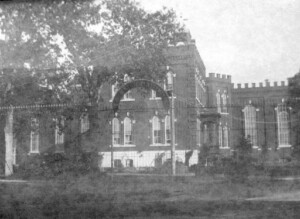Oregon State Penitentiary
Prior to 1866, Oregon convicts were housed in the prison in Portland. On May 16th of that year they were transferred to a temporary wooden facility east of Salem and set to work in the brickyard manufacturing the building materials for a more permanent prison structure.

Blue toned image showing the Oregon State Penitentiary building and gate., WHC Collections 0081.009.0001.006
That first prison offered little in the way of securing convicts inside its stockade and numerous prison breaks occurred in the early years. The only fail-safe device used in those years was “the Oregon boot” or Gardner Shackle, invented by the warden at the Portland prison in 1866. It consisted of a weighted boot to interfere with a prisoner’s ease of walking or running. A picture of the patented shoe stirrup appears in Harry H. Stein’s Salem, a Pictorial History of Oregon’s Capital, and Oregon Historical Society has one of these devices in its collection.
The cornerstone for the new penitentiary was laid August 24, 1871, with appropriate ceremony. It opened for inspection in October of the following year, the modern brick building featured an octagonal administrative structure with three radiating wings. A brick stockade, fourteen feet high, was not completed until 1883, after yet another disastrous prison break.
The most notorious of these escape attempts was that of David Merrill and Harry Tracy on June 9, 1902. After killing three guards, the fugitives made good their escape and touched off a massive Northwest manhunt of three months’ duration. Salem’s daily papers kept up a running account of sightings, false leads, reports from authorities, warnings, and criminal histories of the two escapers. Merrill’s body was found late in June. Tracy was finally cornered in Washington and shot in August. Both were returned and buried in the prison cemetery.
Early in the penitentiary’s Salem history, it was determined that an industrial program should be an essential part of the prisons attempt to rehabilitate convicts. The first effort in this regard was a brick-making machine in 1866. This industry provided employment for the prisoners as well as revenue for the penitentiary up until the 1920s. Other industries were undertaken in the 1870s and 1880s which included a boot and shoe factory, a tannery and saddle tree shop, a saw mill, and one of the most lucrative commercial enterprises, a stove factory. A jute factory, recommended by Governor Pennoyer in 1893, failed to materialize.
Another venture attempted by the prison administrators was a flax industry. In 1875 a flax mill had been established at the penitentiary but met with difficulties from the beginning. Not until 1916 was the industry on a firmer footing, its peak years being in the mid-1940s. During the first World War, prisoners were also recruited to help with flax harvest.
Currently, the major prison industry is furniture manufacturing for the state government and state institutions. Established by Warden Gladden in 1955, following the rebuilding of the prison in modern concrete and steel, the furniture industry provides the majority of prison jobs.
A prison dairy farm annex of 2,089 acres operates five miles south of Salem for minimum security inmates and provides milk and beef for the prison. A forest camp at Tillamook employs another 100 inmates in reforestation and firefighting programs.
Not until 1965 were female felons housed in a separate facility from the men, the Oregon Women’s Correctional Center, adjoining the penitentiary on the east. Prior to that year, female convicts occupied a women’s building within the confines of Oregon State Prison. In this new facility a mattress factory was established and inmates also have the option of working at the Penitentiary Farm Annex.
Researched and written by Sue Bell.
Bibliography:
Capital Journal, 22 July 1916, p. 4.
Daily Oregon Statesman, 9 June 1902 to 8 Aug. 1902, p. 1.
Oregon Blue Book, 1985-1986, p. 235-6.
Oregonian, 4 July 1883, p. 1.
Stauss, Suzanne. “Oregon State Penitentiary,” Historic Marion 35/1 (Spring 1997) : 7.
Stein, Harry H. Salem, A Pictorial History of Oregon’s Capitol. Virginia Beach, Va.: Donning Co., 1981.
This article originally appeared on the original Salem Online History site and has not been updated since 2006.







Leave A Comment